|
Anthoscopus minutus (Cape
penduline-tit)
Gryskapokvoël [Afrikaans]; Kaapse kapokmees [Dutch];
Rémiz de Carol [French]; Weißstirn-beutelmeise [German]; Pássaro-do-algodão
do Cabo [Portuguese]
Life
> Eukaryotes >
Opisthokonta
> Metazoa (animals) >
Bilateria >
Deuterostomia > Chordata >
Craniata > Vertebrata (vertebrates) > Gnathostomata (jawed
vertebrates) > Teleostomi (teleost fish) > Osteichthyes (bony fish) > Class:
Sarcopterygii (lobe-finned
fish) > Stegocephalia (terrestrial
vertebrates) > Tetrapoda
(four-legged vertebrates) > Reptiliomorpha > Amniota >
Reptilia (reptiles) >
Romeriida > Diapsida > Archosauromorpha > Archosauria >
Dinosauria
(dinosaurs) > Saurischia > Theropoda (bipedal predatory dinosaurs) >
Coelurosauria > Maniraptora > Aves
(birds) >
Order: Passeriformes > Family: Paridae
|
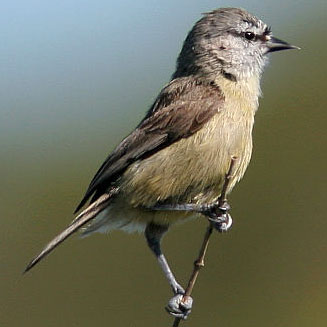 |
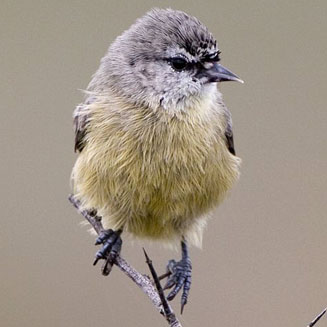 |
|
Cape penduline-tit, West Coast National Park,
South Africa. [photo Trevor Hardaker ©] |
Cape penduline-tit, West Coast National Park,
South Africa. [photo Trevor Hardaker ©] |
Distribution and habitat
Near-endemic to southern Africa, occurring in South Africa, Botswana,
eastern Zimbabwe, Namibia (excluding the Namib Desert) and extralimitally in
south-western Angola. It is locally common across the western half of South
Africa, extending east into the North-West Province, Limpopo Province and
Gauteng. It generally prefers semi-arid or arid dwarf shrubland, as well as dry
Acacia savanna.
|
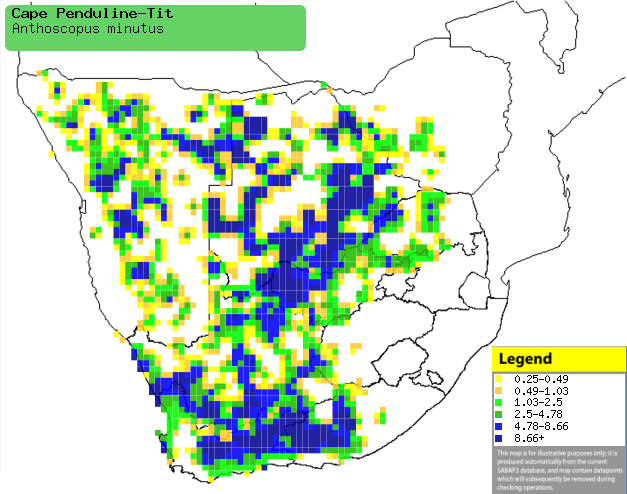 |
|
Distribution of Cape penduline-tit in southern Africa,
based on statistical smoothing of the records from first SA Bird Atlas
Project (©
Animal Demography unit, University of
Cape Town; smoothing by Birgit Erni and Francesca Little). Colours range
from dark blue (most common) through to yellow (least common).
See here for the latest distribution
from the SABAP2. |
Food
It mainly eats insects and their larvae, supplemented with
small fruit. Family groups forage together, gleaning prey from leaves and bark,
often searching spider webs for invertebrates. The following food items have
been recorded in its diet:
Breeding
- Monogamous, facultative cooperative breeder, meaning that the breeding
pair are occasionally assisted by up to two helpers. It usually produces two
broods per breeding season.
- Both sexes construct the nest, which is an oval-shaped bag built of
plant down, wool (sometimes black, from Karakul and Nama sheep), fur of
hares or Angora goats, and other woolly material. A collapsible entrance
spout is placed near the top, which can be opened and closed by drawing the
top and bottom sides of the tube together. Underneath the entrance there is
a small ridge which serves as a perch for the bird to open the entrance
spout with one foot (see images below). The top and bottom of the nest are
usually attached to the twigs of a tree, approximately 1-7 metres above
ground. The top and sides of the nest are usually attached with spider web
to droopy branches of a thorny tree or bush.
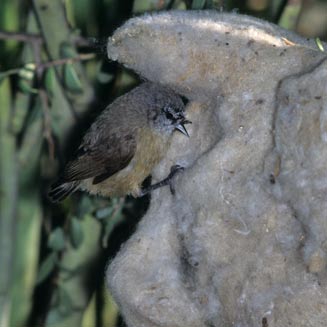 |
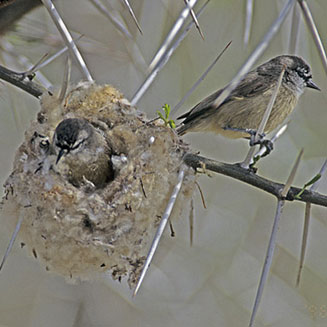 |
| Adult at nest with entrance closed (top left of
nest showing as a horizontal slit). [photo Peter Steyn
©] |
Cape penduline-tits at their nest,
Anysberg, South Africa. [photo Warwick Tarboton ©] |
- Egg-laying season is almost year-round, peaking during summer.
- It lays 4-7 eggs, which are incubated by both sexes for approximately
13-15 days.
- The chicks are fed by both the parents and the helpers, the food
delivery rate increasing as they get older. They leave the nest after 16-22
days, only becoming independent towards the end of the breeding season
(fledglings have been observed to roost with the second brood of chicks)
Threats
Not threatened.
References
-
Hockey PAR, Dean WRJ and Ryan PG 2005. Roberts - Birds of
southern Africa, VIIth ed. The Trustees of the John Voelcker Bird Book
Fund, Cape Town.
|
